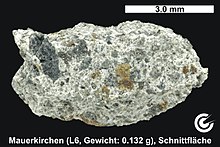Wall churches (meteorite)
| Wall churches (meteorite) | |
|---|---|
| place | Wall churches , today Austria |
| Fall time | November 20, 1768 , around 4 p.m. |
| Coordinates | 48 ° 12 ′ 23 " N , 13 ° 8 ′ 16" E |
| origin | Asteroid flora |
| Meteorite name | Wall churches |
| collection | Museum Kingdom of Crystals |
| authenticity | for sure |
In 1768 there were close to the then Bavarian Mauerkirchen the decline of a meteorite . On November 20th of that year, the heaviest stone meteorite to date, weighing 21.3 kilograms, fell on historically Bavarian territory. At the same time, the Mauerkirchen meteorite is the largest meteorite that has been recovered in what is now Austria's territory . The main piece is now in the Museum Reich of Crystals in Munich.
Historical report
Several eyewitnesses in Mauerkirchen, then Rentamt Burghausen , today Upper Austria , observed the falling meteorite:
“The miracle is as follows: On the evening of November 20th of this year after 4 o'clock in a sky noticeably darkened towards Occident, various honest people in Maurkirchen, who had been questioned about it on oath, heard an unusual roar and tremendous crash in the air, like thunder and shooting with pieces . Under this tumult of the air, a stone fell out of the air into the Georg Bart, mercenary , field. According to the authorities, this stone dug a 2½- shoe deep pit into the earth. "
Shape and composition
The meteorite was found by the farmer Apollonia Bart the day after the fall. Then the meteorite was measured: the stone was not quite a shoe long (around 30 centimeters) and six inches wide (around 15 centimeters). He weighs "38 Bavarian pounds " (around 21.3 kilograms). It is made of “so soft a material that it can be rubbed with fingers. The color of it is blue-fast [bluish] , mixed with a white river or river, but on the outside it is covered with a black bark. "
The meteorite researcher Ernst Florens Friedrich Chladni recorded the meteorite in 1803 in his chronological register of the stone and iron masses that fell with a fire meteor . In later times the geologist Carl Wilhelm von Gümbel analyzed the stone in detail. Gümbel produced a microscopic thin section of the meteorite and described the main mass of the stone as colored light gray and dotted black with interspersed meteor iron. It consists of olivine , feldspar , augite , as well as meteor , sulfur and chrome iron .
Today the Mauerkirchen meteorite is classified as a common chondrite of type L6. The site is about 2 km north of Mauerkirchen in what is now the municipality of Burgkirchen .
Whereabouts of the fragments
The bulk of the Mauerkirchen meteorite was handed over to the natural history cabinet of the Royal Academy of Sciences in Munich, together with the court-sworn protocol of the eyewitnesses. With the establishment of the Bavarian State Natural Science Collections in 1827, the holdings of the Academy, and with it the Mauerkirchen meteorite, were transferred to the State Mineralogical Collection. Other fragments, which were transferred from the estate of King Ludwig I to the Mineralogical State Collection in 1869 , were lost in an air raid during World War II . In contrast to these fragments (and other pieces of Bavarian meteorites), the largest piece survived the air raid, probably because it was inadvertently placed in a location that was not intended for it. Today the main mass of the Mauerkirchner meteorite with a weight of 6.95 kg is exhibited in the Museum Reich of Crystals of the State Natural Science Collections of Bavaria in Munich.
The second largest surviving piece, originally weighing around 4 pounds, came to Göttingen in 1804 as a gift from the then electoral prince and later King Ludwig I to his teacher Johann Friedrich Blumenbach . Fragments of the meteorite can now be viewed in around 80 collections and museums around the world.
See also
literature
- Bavarian State Office for the Environment : Out of this world. Bavaria's meteorite. Self-published, Augsburg 2012, ISBN 978-3-936385-92-2 .
- H. Raab , E. Reiter: On the 250th anniversary of the meteorite fall from Mauerkirchen, Upper Austria. Upper Austrian Geonews, 32, 3-24, Linz 2017 Online
- HG Brandstetter: 250 years of the meteorite fall from Mauerkirchen . Das Bundwerk, 33, 58–65, Ried im Immkreis 2018.
- H. Raab: Miracle upon miracle. In: The Munich Show - Mineralientage München (Hrsg.): The theme book elements. Christian Weise Verlag, Munich, 2018, ISBN 978-3-921656-85-3 , pp. 116–127.
- HG Brandstetter, H. Raab: new details on the discovery of the meteorite from Mauerkirchen, Upper Austria. Upper Austrian Geonews, 33, 57-62, Linz 2018 Online
Web links
- Klaus Buttinger: 250 years of Luftstein von Mauerkirchen. In: Upper Austrian news . 17th November 2018 .
- Michael Vosatka: When a stone fell from the sky in Upper Austria. In: The Standard . 19th November 2018 .
- Entry in the Meteoritical Bulletin Database
Individual evidence
- ↑ a b c H. G. Brandstetter, H. Raab: New details on the discovery of the meteorite from Mauerkirchen, Upper Austria. On-line
- ↑ a b c o.A .: News and treatise from a stone that fell from the air in Bavaria not far from Maurkirchen on November 20, 1768 . Straubing 1769. Online (Bavarian State Library)
- ↑ a b c d H. Raab, E. Reiter: On the 250th anniversary of the meteorite fall from Mauerkirchen, Upper Austria. On-line
- ↑ EFF Chladni: Chronological register of the masses of stone and iron that fell with a fire meteor. In: Annalen der Physik 15 (1803), pp. 307–328, Leipzig Online (Google Books)
- ↑ a b Bavarian State Office for the Environment: Not of this world. Bavaria's meteorite. 2012, 30-31.



